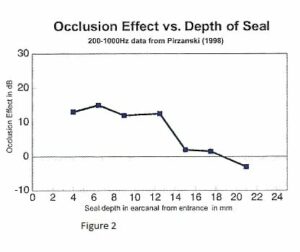I have asked the Queen of Deep Earmold Impressions to be the guest bloggist for today’s entry. Patricia Johnson, AuD, is a research audiologist at Etymotic Research, Inc. She is a past Member Delegate on the Executive Council of the National Hearing Conservation Association, wears hearing protection in loud environments, and always makes long ear impressions.
Maybe a thing or two.
Maybe some things you hadn’t thought of before.
Maybe things no one ever taught you, in all your years of practice.
So please, read on….
For optimum sound quality, serious musicians and audiophiles who need hearing protection wear Musicians Earplugs™, introduced by Etymotic Research in 1988. Musicians Earplugs consist of a filter button that designates the amount of attenuation (9-, 15-, or 25-dB) combined with a custom, deep-sealing earmold. The ER-9, ER-15 and ER-25 filter buttons are made to an exacting standard and are 100% quality-control checked for accuracy. When the Musicians Earplugs filter buttons are combined with earmolds that are made and fitted correctly, there are no better earplugs available anywhere in the world. When the earmolds are not made and fitted correctly, sound quality can suffer and the user does not experience the high-fidelity sound the earplugs were designed to deliver. When there’s a problem with the sound quality of Musicians Earplugs, the source of error is invariably the earmold, which brings us to today’s topic: long ear impressions.
Why long ear impressions?
Ear canals are like fingerprints: no two are exactly alike. This is why impressions are required in the first place. However, if you take an ear impression that goes only to the first bend of the ear canal, chances are very high that the Musicians Earplugs you’re ordering won’t fit correctly and won’t have good sound quality. Shallow ear impressions may be adequate for some hearing aids and earmolds you routinely fit, but they’re inadequate for Musicians Earplugs.
In order to provide the highest sound quality, the earmolds for Musicians Earplugs need to seal at or beyond the second bend of the ear canal. Because of this, earmold impressions for Musicians Earplugs need to go beyond the second bend of the ear canal. What happens if the earmolds are shorter and don’t seal past the second bend? Two things: 1) occlusion effect; and 2) potential problems with the high-frequency response.
Occlusion Effect
The occlusion effect is the increase in sound pressure of low-frequency sound (mostly below 500 Hz) in the occluded ear, as compared to the unoccluded ear. This effect is caused by the vibration of the bony portion of the ear canal wall; the source of the vibration is the user’s own voice or a musical instrument with a mouthpiece, such as a brass or woodwind instrument. The occlusion effect doesn’t occur in the open ear, but it can be quite large when an earmold has a shallow seal (see Figure 1, from Killion et al. 1988).
Numerous studies have confirmed that if an earmold seals at or beyond the second bend of the ear canal (in the bony portion), vibration decreases significantly, which reduces or eliminates the occlusion effect (e.g., Pirzanski, 1998; see Figure 2).
Deeply sealed earmolds can’t be made from shallow ear impressions, so at the risk of becoming repetitious, long earmold impressions are required, well past the second bend!
High-Frequency Directivity
High-frequency sounds are highly directional. If the ear impression is shallow, the earmold manufacturer has to guess at the direction the sound bore should be located. I’ve seen cases where the bore actually points directly at the canal wall, and, not surprisingly, the sound quality wasn’t good. For the earmold to provide the optimum high-frequency signal to the eardrum, the bore should be pointed toward the eardrum. This can only be done if the earmold manufacturer receives an ear impression long enough to allow an accurate estimate of where to place the bore.
The only certainties in life are death and taxes
Even if you’ve done a great job making ear impressions, there is no guarantee that the earmolds will fit properly. I once had a trombone player who was experiencing occlusion effect with his Musicians Earplugs, and I remade one earmold twice and the other one three times before we finally got rid of the occlusion effect! The moral of the story is that even experienced clinicians sometimes need to redo impressions, because ears are like fingerprints, and the science of impression-taking and earmold-making is not exact. But the best place to start is with excellent, LONG ear impressions!
References
Killion MC, Wilber LA, Gudmundsen GI (1988). Zwislocki was right…A potential solution for the “hollow voice” problem (the amplified occlusion effect) with deeply sealed earmolds. Hearing Instruments 39 (1): 14-18.
Pirzanski CZ (1998). Diminishing the occlusion effect: Clinician/manufacturer-related factors. Hearing Journal 51 (4): 66-78.









Patricia,
I enjoyed your post as well as humor on the affect of occlusion and quality of sound in outcomes.
Thanks
Rich Reikowski, Au.D
hearinglossohio.com